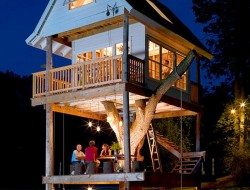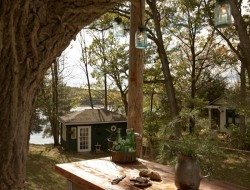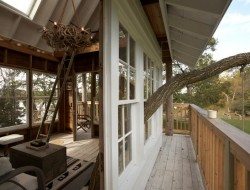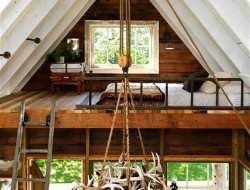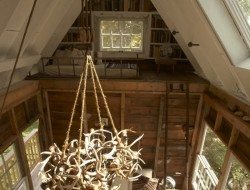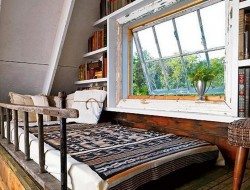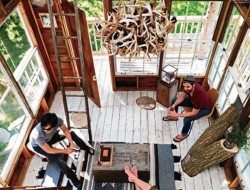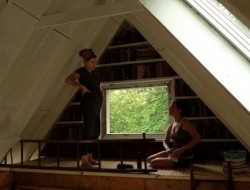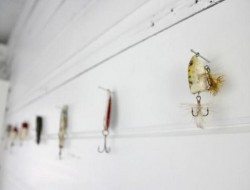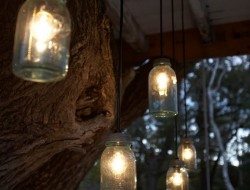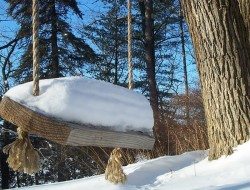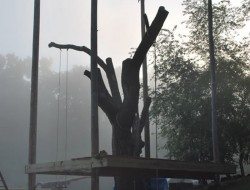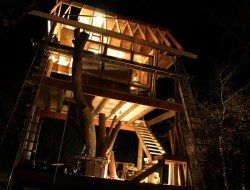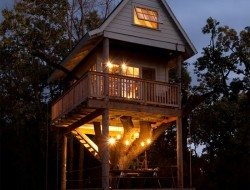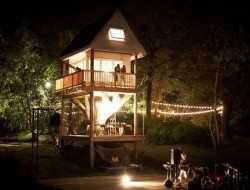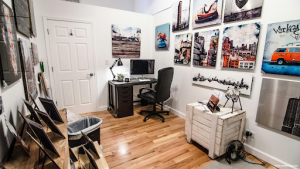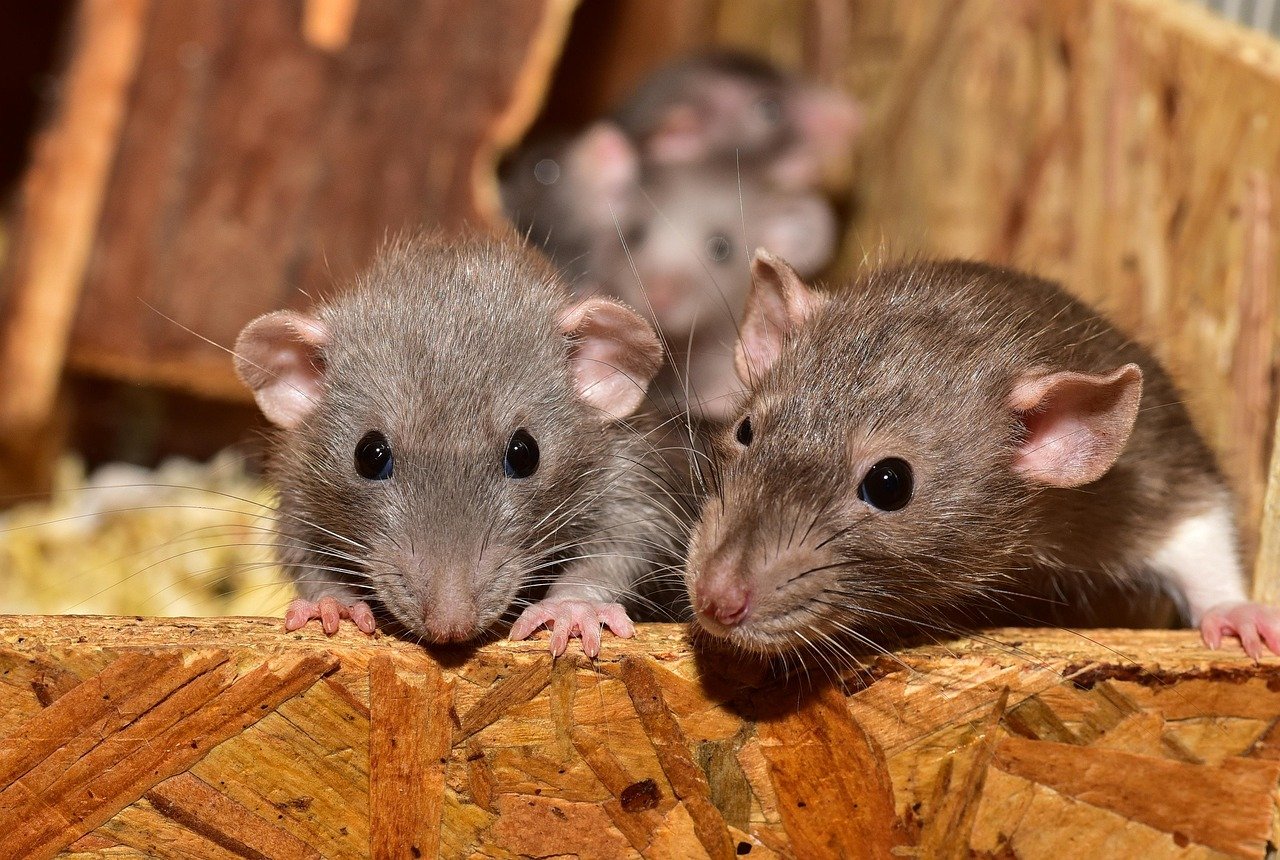Last Updated on July 22, 2024 by teamobn
Elkhorn, Wisconsin – Camp Wandawega
There is a lovely story behind this unique house. When the property was first purchased by a couple, her father hung a swing in the branches of this tree to “christen” it. Shortly after this, her father passed away, and the tree contracted a disease. Rather than cut it down completely, they trimmed it back to the wood that was still sound.
You’ll find the video below this gallery.
Click on any image to start lightbox display. Use your Esc key to close the lightbox. You can also view the images as a slideshow if you prefer ![]()
http://www.youtube.com/watch?feature=player_embedded&v=XWfqNmsVvsU
Building Process of a Camp Treehouse
Are you dreaming of having your own camp treehouse at home? Continue reading our DIY guide on how to build one!
Materials
- Telephone posts: Used for the main supports to ensure stability.
- Concrete pilings: To anchor the posts securely into the ground.
- Recycled wood: For the flooring, walls, and interior structures.
- Glass windows: To allow natural light and provide views of the surrounding area.
- Metal brackets and screws: For secure joints and enhanced durability.
- Repurposed furniture: Handmade or salvaged items used to furnish the interior.
Tools Required
- Power drill: For drilling holes and driving screws.
- Circular saw: To cut wood to the required sizes.
- Hammer and nails: For additional bonding and structural support.
- Level: To ensure all parts of the structure were even and stable.
- Measuring tape: For precise measurements during construction.
- Safety gear: Including gloves, goggles, and helmets for protection.
Instructions
Step 1: Design and Planning
Start by sketching out your design on paper, considering the size, height, and features you want in your camp treehouse. Assess the health and stability of the tree you’ll use, ensuring it can support the structure. Obtain any necessary permits from your local authorities to ensure your build is compliant with local regulations.
Step 2: Gather Materials and Tools
Collect all the materials and tools you’ll need for the project.
Step 3: Lay the Foundation
Using the telephone posts, create a sturdy base. Dig holes to set the posts six feet into the ground, securing them with concrete pilings. This foundation will support the camp treehouse and ensure its stability.
Step 4: Construct the Frame
Attach horizontal beams to the telephone posts to form the floor frame of your camp treehouse. Ensure everything is level and securely attached. Then, construct the walls and roof frame, attaching them to the floor frame.
Step 5: Install the Floor, Walls, and Roof
Lay the flooring material on the frame, securing it with screws. Follow with the walls and then the roof, using your chosen materials. Make sure to seal any gaps to protect the interior from the elements.
Step 6: Add Windows and Doors
Cut out spaces for windows and doors, installing them to allow light and access. Ensure that windows are secure and that the door fits well within its frame.
Step 7: Build Interior Features
Depending on your design, add interior features like built-in benches, a loft area, or storage spaces. Custom features can make your camp treehouse more functional and comfortable.
Step 8: Finish and Decorate
Finish the exterior and interior with paint or stain to protect the wood and give your treehouse a finished look. Decorate the inside with comfortable furnishings and fun elements like curtains, cushions, and perhaps even a small battery-powered light system.
Step 9: Install Safety Features
Ensure the safety of all camp treehouse users by installing sturdy railings around open spaces and entryways. Regularly inspect the structure for any signs of wear or damage, especially before and after harsh weather.
Step 10: Enjoy Your Camp Treehouse
Once everything is built and decorated, it’s time to enjoy your new retreat. Whether it’s a space for relaxation or play, your camp treehouse will provide a unique and personal escape in the great outdoors.
Interior Design and Decoration
The interior design and decoration of a camp treehouse can transform a simple structure into a cozy, inviting retreat that blends rustic charm with functional living space. By carefully selecting materials, colors, and furnishings that resonate with the natural surroundings, you can create an interior that feels both intimate and adventurous. Here’s how you can achieve a harmonious design for your camp treehouse, inspired by the enchanting interiors seen at Camp Treehouse.
Concept and Color Palette
Start by defining a theme that fits the natural environment of your camp treehouse. Earth tones such as greens, browns, and beiges are perfect as they reflect the colors of the forest and help the structure blend with its surroundings. Accents in brighter colors like sky blue or sunset orange can add vibrancy without overwhelming the natural palette.
Materials and Textures
Choosing natural materials is key to crafting an authentic camp treehouse experience. Use reclaimed wood for walls and floors to add warmth and character. Incorporate rough stone in areas like the fireplace or kitchenette to enhance the rustic feel. For textiles, opt for natural fibers like cotton, linen, and wool, which provide comfort and durability. Burlap curtains or hemp area rugs can complement the aesthetic while adding texture.
Furniture Selection
Furniture should be functional, space-efficient, and durable. Opt for pieces that can serve multiple purposes in your camp treehouse, such as a bench that doubles as storage or a fold-down table that saves space when not in use. Custom-built items can maximize space and fit the unique contours of the treehouse. Choose furnishings that reflect the rustic theme, such as a rocking chair, a small wood stove, or a daybed with lots of pillows for relaxation.
Lighting
Good lighting is essential, especially in a treehouse where natural light might be limited due to the surrounding foliage. Install battery-powered LED lights for a safe and reliable light source. Solar-powered outdoor lights can be used to illuminate the entrance or balcony. For a charming touch, use lanterns or repurposed mason jar lights to create a soft, ambient glow in the evenings.
Decorative Accents
Decorative elements should reflect a love of nature and adventure. Display items like vintage maps, botanical prints, or wildlife artwork to emphasize the theme. Shelves made from branches or driftwood can hold books or decorative items. Incorporate elements from the surrounding area, such as pine cones, stones, or shells collected during walks.
Utilizing Small Spaces
In a compact area like a treehouse, every inch counts. Use vertical space for storage, installing hooks for hanging items or netting for holding bedding or clothing aloft. Convertible furniture, such as a Murphy bed or a lofted sleeping area, can maximize floor space during the day.
Personal Touches
Finally, personalize your camp treehouse to make it feel like home. This could include a guest book for visitors to share their experiences, a cozy throw blanket for chilly nights, or a small collection of board games for entertainment. These personal touches make the space welcoming and uniquely yours.
Innovative Storage Solutions
In a compact space like a treehouse, smart storage solutions are crucial. Consider under-floor storage compartments that can hide away bedding or seasonal items. Wall-mounted magnetic strips are great for hanging tools or kitchen utensils, saving counter space and keeping essentials at hand.
Eco-Friendly Elements
Incorporate eco-friendly elements to maintain sustainability in your design. Use solar panels to power interior lights or small appliances. Install a rainwater catchment system for watering plants on the balcony or cleaning. Opt for paints and finishes that are low in volatile organic compounds (VOCs) to maintain indoor air quality.
Window Treatments
Choose window treatments that maximize natural light while providing privacy and insulation. Lightweight, translucent curtains can diffuse light and add a soft texture to the space. During colder months, heavier drapes can provide additional insulation.
Floor Coverings
Lay down floor coverings that add warmth and comfort. Thick rugs or sheepskins can provide a cozy surface underfoot, especially in sleeping areas or beside the bed. Choose materials that are easy to clean and durable, especially if the treehouse is exposed to dirt and debris from the outdoors.
Artistic Features
Create focal points with artistic features that draw the eye and spark conversation. Install a sculptural piece made from natural materials, or use a section of the wall for a chalkboard or magnetic paint, allowing guests or kids to leave their mark or express creativity.
Multifunctional Furniture
Invest in or build multifunctional furniture that can adapt to different needs. A pouf or ottoman with storage inside can serve as seating, a footrest, or a coffee table. A ladder to a loft can have built-in shelves or cabinets along its side.
Outdoor Integration
Design the interior to harmonize with an outdoor seating area or balcony. Use similar materials and colors inside and out to create a seamless transition. Outdoor cushions can be made from the same fabric as indoor ones, and indoor lighting can mimic the style of outdoor fixtures.
Soundproofing
Incorporate soundproofing elements to enhance the tranquility of your treehouse. Use insulated panels or thick carpets to reduce noise transmission. This is particularly useful if the treehouse is near a busy area or is used for relaxation and escape.
Reflective Decor
Use mirrors strategically to make the interior feel larger and more open. A well-placed mirror can reflect light from a window, brightening the space and offering views of the surrounding landscape from different angles.
Thematic Touches
Add thematic touches that relate to the purpose or location of the treehouse. For a beach-side treehouse, seashell and coral motifs can be charming. In a forest setting, leaf patterns and wood carvings would enhance the theme.
By following these guidelines, the interior of your camp treehouse will not only be stylish and comfortable but also a true reflection of the environment it inhabits, much like the well-loved Camp Treehouse. This approach ensures that your treehouse is not just a place to stay, but a destination in itself, inviting relaxation and reflection in equal measure.
Conclusion
The Camp Treehouse experience combines the rustic charm of nature with the comforts of modern design, creating a unique retreat that captures the imagination and soothes the soul. Every detail, from the eco-friendly construction to the personalized interior decorations, ensures that guests feel both adventurous and at home. This magical hideaway offers an unforgettable escape into the tranquility of nature, making every visit a cherished memory.
If you enjoyed this, you will probably like these homes…

